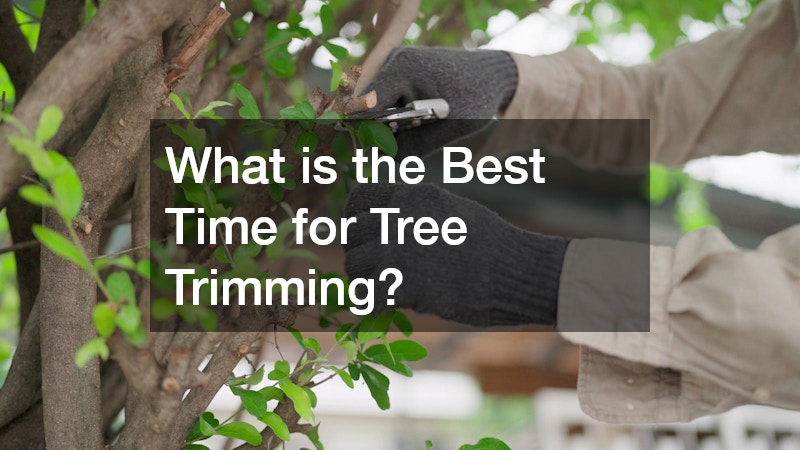Maintaining healthy and attractive trees requires more than just watering and fertilising. One of the most important tasks in tree care is knowing when and how to trim them. Tree trimming not only improves a tree’s appearance but also promotes stronger growth, increases safety by removing hazardous limbs and can even enhance the value of your property. But when is the best time for tree trimming?
Understanding Tree Growth Cycles
Before diving into the ideal timing, it’s essential to understand a tree’s natural growth cycle. Trees typically have two main phases each year: the growing season and dormancy.
In Australia, most trees grow actively during spring and summer and then enter a period of rest in autumn and winter.
The dormant season is when a tree conserves its energy, making it an ideal time for structural changes such as trimming. Trimming during dormancy minimises sap loss, reduces the risk of disease and allows trees to heal faster in spring when growth resumes.
General Rule: Winter Is Ideal
For most tree species, the best time for trimming is late winter to early spring, just before new growth begins. This period allows for maximum exposure of the tree’s structure without the obstruction of leaves, making it easier to identify problem areas such as dead or crossing branches.
In temperate regions of Australia, such as Melbourne and Sydney, this means June through August is generally the optimal window. Trimming in winter also ensures your tree enters the growing season with a healthy framework, encouraging vigorous and balanced growth.
When to Trim Flowering Trees
Flowering trees can be a bit trickier, as the timing depends on whether the tree flowers on new or old growth. Trees that bloom in spring, such as magnolias or cherry blossoms, should be trimmed after flowering. These trees develop their flower buds on the previous season’s growth, so trimming before blooming could remove the very buds that produce flowers.
On the other hand, trees that bloom in summer or autumn, such as crepe myrtles, typically flower on the current season’s growth and can be safely trimmed in late winter or early spring. Understanding your tree’s flowering pattern will help you schedule trimming at a time that doesn’t compromise its aesthetic appeal.
Avoid Trimming During Peak Growth or Stress
There are times when trimming can be harmful, especially if done during a tree’s peak growth phase or during periods of environmental stress. Trimming in late spring or early summer can disrupt a tree’s energy production, while trimming during drought or extreme heat can hinder recovery and cause additional stress.
Similarly, trees recovering from pest infestations, disease or storm damage should be assessed by a professional arborist before undergoing further trimming. Improper timing or technique can weaken the tree further and may even be fatal.
Special Cases: Emergency Trimming
While timing is important, safety always takes priority. If a branch is dead, damaged or posing a hazard to people or property, it should be removed immediately, regardless of the season. Emergency tree trimming can prevent accidents and reduce the risk of further damage during storms or high winds.
If your tree is growing into power lines, overhanging structures or interfering with sightlines, it’s best to consult a certified arborist to safely remove the offending branches.
Hiring Professionals for Best Results
Although minor trimming can be a DIY task, major tree trimming—especially of large or mature trees—should be left to professionals. Trained arborists can determine the optimal time and method for trimming each species, ensuring your trees remain healthy and structurally sound.
Professionals also have the equipment and expertise to trim trees safely, particularly when dealing with heights or potentially dangerous limbs.
Benefits of Proper Timing
Trimming your trees at the right time has several benefits. It encourages strong, healthy growth and improves structural integrity. Well-timed trimming also enhances flowering and fruit production, reduces the risk of disease or pest infestation and increases property value and curb appeal.
When timed correctly, tree trimming becomes a proactive part of tree maintenance rather than a reactive chore.
Final Thoughts: Timing Is Key to Healthy Trees
Tree trimming is both an art and a science and getting the timing right is key to maintaining beautiful, healthy trees. For most regions in Australia, the late winter to early spring period is ideal, but climate, species and specific tree health can shift this window. Understanding your tree’s needs—and your region’s growing conditions—will help you determine the best time to trim.
When in doubt, consulting an arborist ensures you make the right decision for the long-term health of your trees. With proper timing and care, your trees will flourish and continue to be a valuable part of your landscape for years to come.
.

